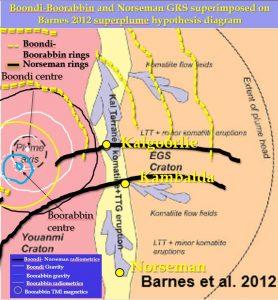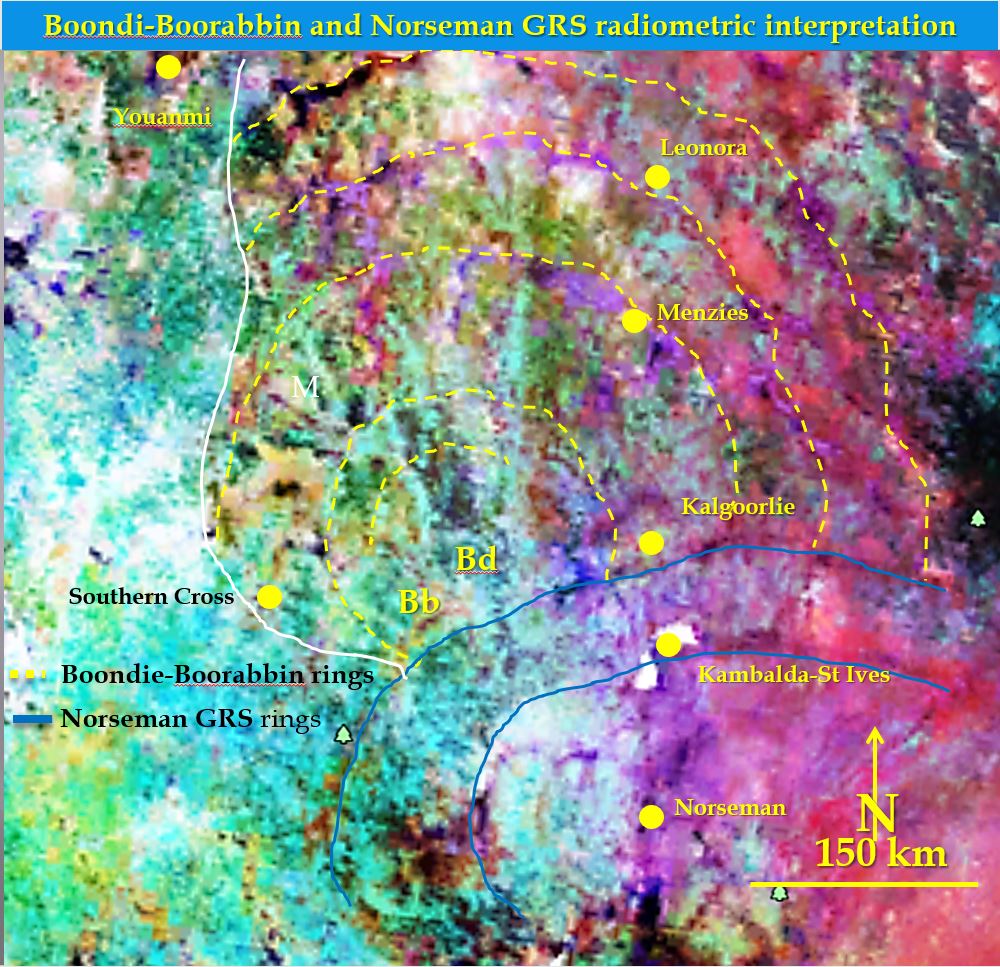YBB #1. Boondi-Boorabbin Giant Ring Structure cluster, Southern Cross area, Yilgarn, Western Australia. Remnant Archaean Superplume, Metamorphic core complex or Impact Structure?

Summary
This paper is the first in a series that will document the Boondi-Boorabbin giant ring structure cluster (GRS) in the Yilgarn Craton as observed in geoscientific data. These papers are designed as a springboard for advancing the study of the Yilgarn and is empirical research of observations. Speculation on a possible superplume origin of the Southern Yilgarn GRS cluster is developed at the end of the paper.
Boondi-Boorabbin was only discovered in late October 2017 when the cause of the pattern of arcuate palaeochannels was being investigated on radiometrics. The Boondi giant ring structure centre is located at 30˚ 57’S and 120˚30’E, about 85 km west of Kalgoorlie and 25 km north of Boondi rock on the Great Eastern Highway. Boorabbin giant ring structure centre is located at 31˚ 12’S and 120˚18’E at the Boorabbin memorial about 100 km east of Southern Cross. The Boondi-Boorabbin giant ring structure can be observed in gravity, topography and magnetics but most clearly in K/Th/U radiometrics.
Geology. The Boondi-Boorabbin giant ring structure cuts across all regional geology and there is no large-scale evidence that it is a product of the regional geology which consists of NNW trending greenstone belts in a matrix of gneiss and granite.
Radiometrics. The outer rings are observed as a series of overlapping rings emanating from these two proximate GRS centres. The Boondi-Boorabbin giant ring structure has a 240km radius to the Leonora ring. There are rings in Palaeochannels out to 300 km (Darlot) which suggests an original 600 km diameter, if symmetrical. The western half is truncated along the Southern Cross-Youanmi line (Terrane boundary). This line corresponds to the westward extent of the greenstone belts and large palaeochannel systems. It is also the commencement of surface lithologies with uranium rich – thorium depleted radiometrics that has a blander, less textured appearance. As the Cauden, Malgar and Barrambie GRS appear to be relatively undisturbed the movement on this boundary may be mainly west up exposing the older crust. The geochronology indicates this is the oldest crust, has had more surface greenstone crust eroded, and has undergone more prolonged deformation and metamorphism.
The southern half of Boondi-Boorabbin is cut off by the Norseman GRS. The Norseman GRS overprints the Boondi-Boorabbin GRS in radiometrics suggesting that it is a younger, or stronger, structure.
Residual gravity, which highlights near surface greenstones, shows that that there are few greenstones that follow the Boondi-Boorabbin rings suggesting that they were not intruded along these rings. This may mean that either the rings are post the last greenstone intrusions (post 2.7 Ga) or the actual Boondi-Boorabbin GRS structures are not tapping the mantle and are thus different from the GRS studied so far. The Boondi and Boorabbin GRSs have different gravity signatures at their centres. Boondi has a large (~30km) gravity low centre. There are poorly developed roughly semicircular gravity features (30 km radius) in the southern half of the Boondi GRS. These have a similar gravity signature to the later granites found in field studies of the western ring of the Cauden GRS (Watchorn YC#1 2017). Boorabbin has a well formed (but small, ~5 km) gravity high ring centre. This centre has an annulus (70 km width) of moderate more homogenous gravity signature with an outer margin which overprints the gravity of the Boondi GRS.
Magnetics. In the 1500 TMI (long wavelength) magnetic data the Boorabbin feature appears as a 2km diameter magnetic high centre with a narrow annulus of lower magnetic intensity surrounded by a well-formed 70 km diameter higher magnetic rosette. The Boorabbin rosette is different in appearance to Watchorn and O’Driscoll GRS central magnetics which have a high central ring surrounded by magnetics of decreasing intensity that overprint the surrounding lithologies. The Boondi GRS centre is not visible in the 1500 TMI magnetics.
Genesis. It is suggested that the Boondi-Boorabbin and Norseman GRSs, and the large number of rings trending to the NW, may have resulted from a superplume and its subsequent breakup.
| YBB#1 Boondie GRS introduction paper 1.pdf | 4 MB |

